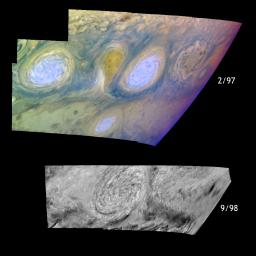
|
Historic Merger of Storms on Jupiter
- Click the image above for a larger view
- Full-Res JPEG (900 x 900) (75.1 kB)
- Full-Res TIFF (900 x 900) (1.2 MB)
Caption:
Jupiter's white oval storms before (top) and after (bottom) their historic merger in February 1998. The three classic white ovals which formed in the 1930's have occupied the band from 31 to 35 degrees south planetocentric latitude ever since. The top panel shows two of the ovals with a pear-shaped region between them. Winds around the white ovals are counterclockwise (anticyclonic), indicating they are high-pressure systems. Winds around the pear-shaped region are clockwise (cyclonic), indicating that it is a low-pressure region. The two white ovals were named BC (right) and DE (left) shortly after they formed. The lower panel shows the merged oval, named BE. The pear-shaped cyclonic region is absent. The merger took place in February 1998 when Jupiter was behind the Sun and could not be seen from Earth.
The top and bottom panels show the features in the same viewing geometry. One might expect the area of the merged feature to equal the sum of the areas of the original features, but the oval might have lost some material during the merger or it might have stretched out in the vertical direction. Vertical stretching causes the ovals to spin faster, similar to what happens when figure skaters spin and pull their arms closer to their bodies. The images allow determination of both the areas of the storms and the related winds; this will help distinguish among the mechanisms involved.
The top mosaic combines images obtained using the Galileo imaging camera's three near-infrared filters (756, 727, and 889 nanometers displayed in red, green, and blue respectively) to show variations in cloud height and thickness. Light blue clouds are high and thin, reddish clouds are deep, and white clouds are high and thick. The clouds and haze over the white ovals are high, extending into Jupiter's stratosphere. There is a lack of high haze over the cyclonic pear-shaped feature between the ovals. Dark purple most likely represents a high haze overlying a clear deep atmosphere. Galileo is the first spacecraft to distinguish cloud layers on Jupiter. The bottom mosaic uses images obtained with the camera's 756 nanometer filter only.
North is at the top of these mosaics. The smallest resolved features are tens of kilometers in size. The top images were taken on February 19, 1997, while the bottom images were taken on September 25, 1998, all at ranges of about 1 million kilometers (620,000 miles) by the Solid State Imaging (CCD) system on NASA's Galileo spacecraft.
Background Info:
The Jet Propulsion Laboratory, Pasadena, CA manages the Galileo mission for NASA's Office of Space Science, Washington, DC.
This image and other images and data received from Galileo are posted on the World Wide Web, on the Galileo mission home page at URL http://solarsystem.nasa.gov/galileo/ . Background information and educational context for the images can be found at http://www.jpl.nasa.gov/galileo/sepo .
Cataloging Keywords:
| Name | Value | Additional Values |
|---|---|---|
| Target | Jupiter | |
| System | Jupiter | |
| Target Type | Planet | |
| Mission | Galileo | |
| Instrument Host | Galileo Orbiter | |
| Host Type | Orbiter | |
| Instrument | Solid-State Imaging (SSI) | |
| Detector | ||
| Extra Keywords | Atmosphere, Color, Haze, Infrared, Rotation, Storm | |
| Acquisition Date | ||
| Release Date | 1998-12-07 | |
| Date in Caption | 1997-02-19 | 1998-09-25 |
| Image Credit | NASA/JPL-Caltech | |
| Source | photojournal.jpl.nasa.gov/catalog/PIA01650 | |
| Identifier | PIA01650 | |
